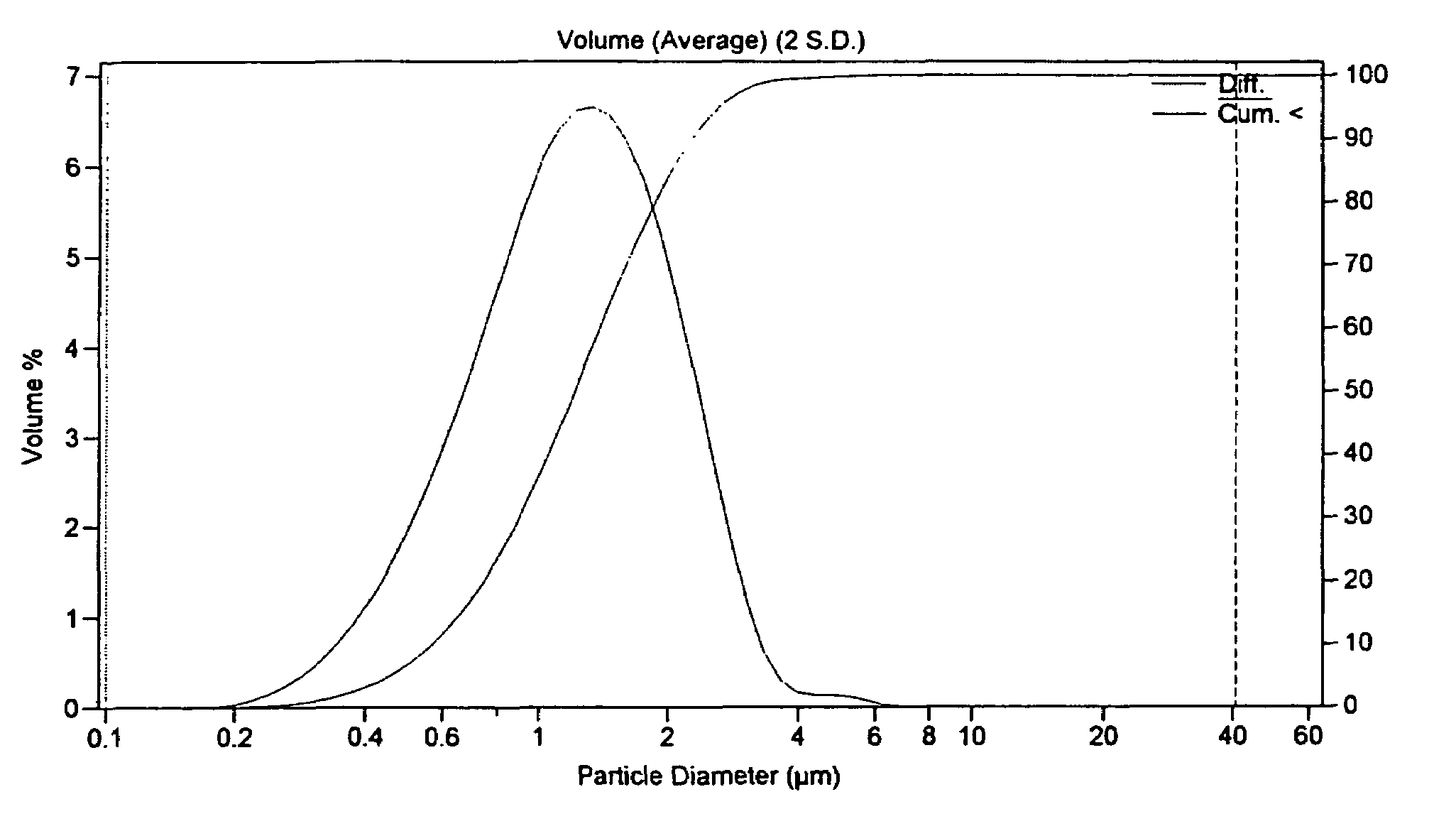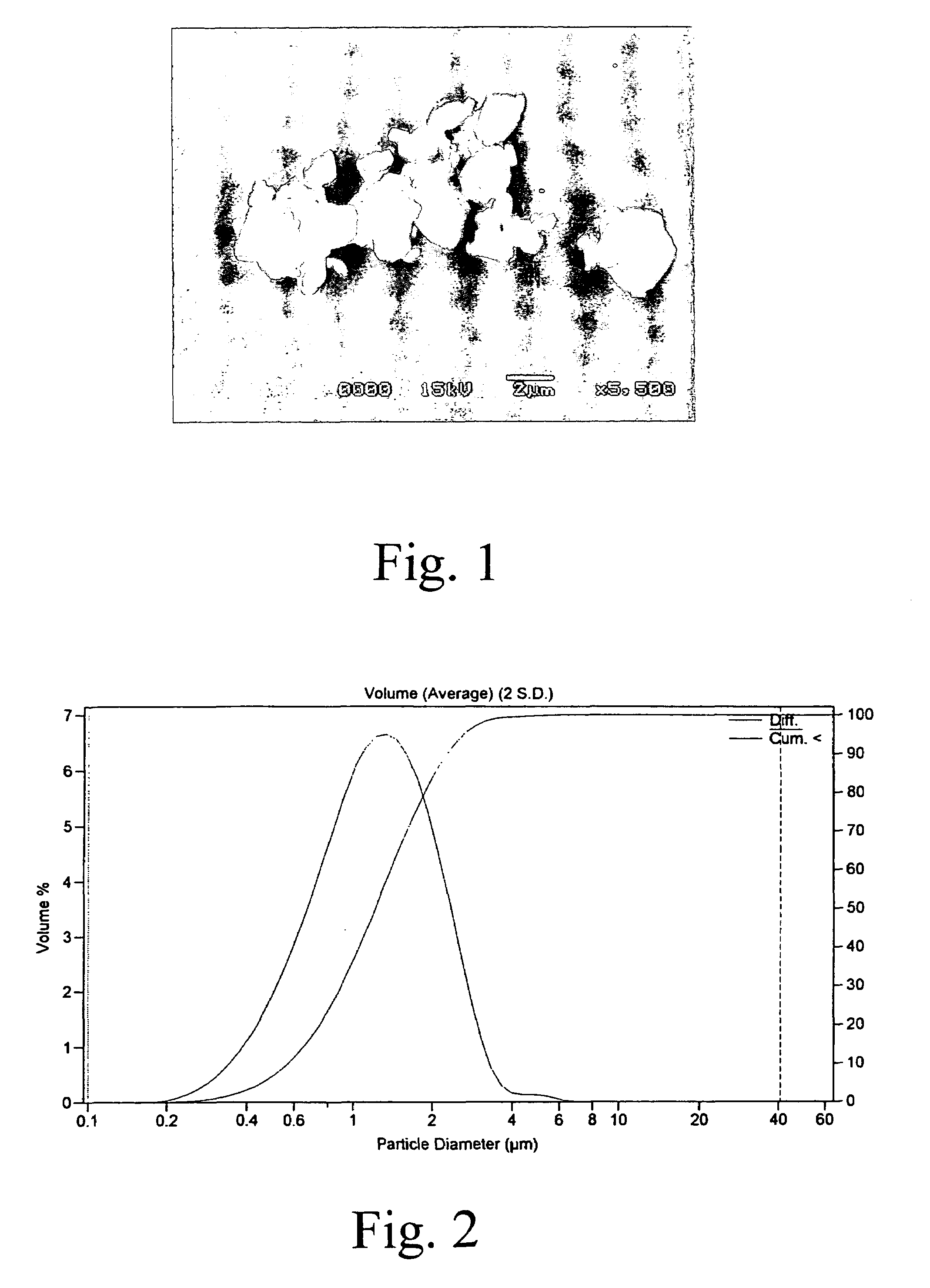Filler and pigment
a technology of a applied in the field of filter and a pigment, can solve the problems of reducing the strength of the paper, forming an extra cost load, and reducing the efficiency of the recirculation fiber, so as to improve the heat/fire resistance, reduce the opacity, and reduce the grammage. the effect of opacity
- Summary
- Abstract
- Description
- Claims
- Application Information
AI Technical Summary
Benefits of technology
Problems solved by technology
Method used
Image
Examples
example 1
Manufacture of a Calcium Oxalate Product of Pigment-Quality and the Particle Size of the Calcium Oxalate
[0044]Calcium oxalate monohydrate powder (CaC2O4×H2O) of laboratory quality was slurried in water. The slurry was milled in a ball mill with 1 mm glass pearls without additives. The milled material was drained with a ceramic filter and the particle size distribution of the product was assayed with a Coulter LS (cf. FIG. 2). Numerically the particle size distribution was as follows:
[0045]
TABLE 1Pigment size distribution of milled calcium oxalate%1025507590Size, μm0.6760.9921.4912.1732.920
[0046]Thus, the particle size distribution of calcium oxalate is rather narrow which is beneficial for good optical properties.
[0047]The dry matter content of the product was 54 wt-% and the average particle size 1.4 μm.
example 2
Determination of Specific Area and Wearability of Calcium Oxalate
[0048]Using the milled slurry of Example 1 the wear caused on the wire and the specific area (BET) of Ca oxalate were determined.
[0049]The BET specific area of the sample was 4.4 m2 / g. The specific area of calcium oxalate was on the same order as for some PCC qualities.
[0050]The wearability of calcium oxalate was 2.79 g / m2. In Table 2, calcium oxalate has been compared to traditional pigments.
[0051]
TABLE 2WearabilityPigmentWearability, g / m2ZnO, red lable12.5ZnO, gold lable0.7CaCO3, HC9036.2PCC (skalenoedrical)6.0SPS kaolin10.1Talc13.0Calcium oxalate2.49
[0052]As the table clearly shows, calcium oxalate causes clearly less wear on the wire than most of the conventional pigments.
example 3
[Esimerkki]
Determination of the Optical Properties of Coating Layers and of Coated Paper
[0053]The slurry of Example 1 was also subjected to determination of the light scattering and light absorption coefficients (Y and R475) of Ca oxalate. The determinations were made on both glass sheets and base paper. The optical properties determined comprised the S- and K-values and the opacities. The values were determined at two different wave lengths (viz. 557 nm and 457 nm).
[0054]In order to determine the properties of the calcium oxalate film the pigment slurry was first applied on a glass sheet using a paste spreader with two different thicknesses of the layers.
[0055]From the films made on the glass sheets, Ro and Roo were first determined from the coated part. A piece of cardboard which had been coated with Ca oxalate slurry was used as background for the determination of the Roo. For determining the thickness of the layer the thickness of the glass sheet was determined both for the coat...
PUM
| Property | Measurement | Unit |
|---|---|---|
| temperature | aaaaa | aaaaa |
| temperature | aaaaa | aaaaa |
| particle size | aaaaa | aaaaa |
Abstract
Description
Claims
Application Information
 Login to View More
Login to View More - R&D
- Intellectual Property
- Life Sciences
- Materials
- Tech Scout
- Unparalleled Data Quality
- Higher Quality Content
- 60% Fewer Hallucinations
Browse by: Latest US Patents, China's latest patents, Technical Efficacy Thesaurus, Application Domain, Technology Topic, Popular Technical Reports.
© 2025 PatSnap. All rights reserved.Legal|Privacy policy|Modern Slavery Act Transparency Statement|Sitemap|About US| Contact US: help@patsnap.com


